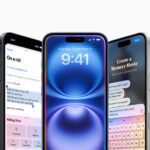Li-Fi is real and could be coming to the next iPhone which some believe is the iPhone 7. This seems to be the case according to code breaker Chase Fromm who published this on Twitter as seen in the diagram below;
Li-Fi also know as Light Fidelity is said to be over 100 times faster than the traditional Wi-Fi with speeds of 100Gbps and theoretical output of 224Gbps as opposed to 7Gbps for Wi-Fi. In this video,
While traditional Wi-Fi is capable of transmitting data at around 7 gigabits per second (Gbps), Li-Fi tests have shown it can transfer information at more than 100 Gbps, with a theoretical output of 224 Gbps. Prof. Professor Harald Haas of the University of Edinburgh first used the term in 2011. You can watch him this Ted video talk about this important discovery. Li-Fi “is a form of visible light communication and a subset of optical wireless communications (OWC) and could be a complement to RF communication (Wi-Fi or Cellular network), or even a replacement in contexts of data broadcasting. It is so far measured to be about 100 times faster than some Wi-Fi implementations, reaching speeds of 224 gigabits per second” according to one definition. This simply means your light bulbs could eventually become your access point in the future where download of an average movie could now be seconds.
A light bulb would be fitted with a microchip which would eventually transform it into an access point from where you can access data. The diagram below explains better how this would eventually work according to this article by Moazzam Khan on LinkedIn;
Pictorial representation of the Li-Fi by Moazzam Khan
When this finally becomes a commercial reality, here’s what to expect;
- You would need to install the Li-Fi LED lighting that suits you and of course this is based on market availability at the time.
- Add a Li-Fi key to your mobile device.
- Download Li-Fi applications on the Play Apps portal and that should be it.
Is this going to eventually replace Wi-Fi as we know it?
Well Wi-Fi won’t go extinct according to this researcher who leads the Li-Fi team in Germany. Separately, the Fraunhofer Institute for Photonic Microsystems, in Dresden, Germany, had announced plans to demonstrate a Li-Fi hot spot in November (after press time) at the Electronica 2014 trade show in Munich. Frank Deicke, who leads the team developing Li-Fi at Fraunhofer, says that the system would most likely use infrared light and is aimed at industrial users rather than consumers. The hot spot was set to be a point-to-point link with a data rate of up to 1 Gb/s.
“You can have more or less the same data rate as over a USB cable,” Deicke says. “That’s very challenging for most wireless technologies, like Wi-Fi and Bluetooth.” Another advantage, says Deicke, is that the latency of Wi-Fi—the time between when a signal is sent and when it’s received—is measured in milliseconds, whereas Li-Fi’s latency is on the order of microseconds. In industrial applications, where data has to flow between sensors, actuators, and a control unit, low latency and high data rates would make Li-Fi useful in places where Wi-Fi is not. “We don’t want to replace Wi-Fi,” he says. “That’s not our goal.”
This technology is still in the developmental stage and s experts think it may not feature in the iPhone 7 which is expected to launch sometime in September. The research is currently being funded in the UK by Engineering and Physical Sciences Research Council to the tune of £5.4m/1.5b Naira/750m KES.
Read More
Here are some articles I believe could shed more light on this technology for you.
Li-Fi Gets Ready to Compete With Wi-Fi– Neil Savage via IEEE Spectrum
Li-Fi- A Technology 100 Times Faster Than Wi-Fi– Moazzam Khan on LinkedIn
iOS code shows Apple experimenting with ultra fast, light-based Li-Fi wireless data for future iPhones – by Sam Oliver via Apple Insider

















